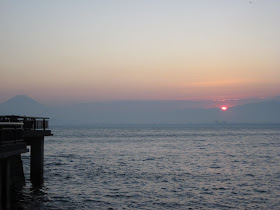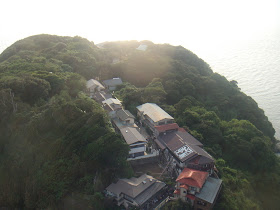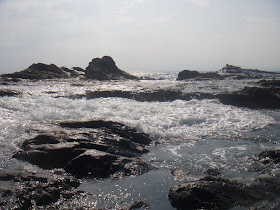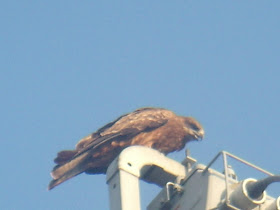At the top of this elevator, the next spot is Nakatsunomiya Shrine of the Enoshima Shrine. This shrine was the original, built on top of the island enshrining the goddess, Ichikishimahime. It was rebuilt in 1689 and remodeled in 1996. [1]
 |
| Nakatsunomiya Shrine |
 |
| Some of the wood carving details on the shrine. The carvings on this one are much more intricate than the previous shrine. |
 |
| More detail from the shrine, this time of the dragon which is the common motif on the island. |
A little bit further up the path is the Samuel Cocking Garden and the Lighthouse at the summit of the island. If it seems strange that an island based so much on the traditional and native Shinto religion would have a garden with a foreign name, you'd probably be correct. The history of the development of this garden is certainly a surprising one. First for the story of the person who the garden is named after. Samuel Cocking was a British merchant who was able to enter Japan in 1869, right after the Meiji Restoration that allowed for much more foreign interaction than the previous Edo Era; which was relatively isolated until Admiral Perry opened up Japan in 1854. Making a fortune in the selling of herbs, Samuel Cocking bought the land on Enoshima through his wife's name and built a garden and huge greenhouse there, being novel for Japan at the time. [2] Why this land was for sale is an entirely different story.
Japan ending its period of relative isolation was only one of the many changes that happened in Japan after the Meiji Restoration. Another major one was the 'Abolish the Buddha. Destroy Sakyamuni' policy instituted after the restoration. Shinto became the official religion to Japan following the Meiji Restoration (possibly to help somewhat re-legitimatize the Emperor's control of Japan at the time). Enoshima would have gained popularity at this time, but the many Buddhist buildings on the island at this time were destroyed and sold off. [3] This sale from the abolishment of Buddhism from the island was what allowed Samuel Cocking to purchase the land in the first place. Even the Benten statues that were popular and famous on the island previously, were discarded at this time and almost destroyed, losing much of the original craftsmanship. [4]
 |
| The garden entrance and lighthouse in the background. |
 |
| Some pictures from inside the garden. |
Besides the variety of flower and plants that make up the garden, there is also a variety of historic structures and modern internationalism in the garden. The historic being the remains of the garden from Samuel Cocking's time. He had built a large greenhouse at the time, considered to be the largest in the East, but was destroyed in the great Kanto earthquake of 1923 and currently is considered to be the only brick greenhouse to be excavated. [5]
In terms of the international, the garden now has themed areas for the 5 sister cities of Fujisawa. These include themed areas for: Matsumoto City, Japan, Miami Beach, USA, Boryeong City, Korea, Windsor City, Canada and Kunming City, China. [6] The Kunming City garden section gave the best impression with its traditional gazebo being beautiful and providing a peacock statue as well.
 |
| The traditional Gazebo from Kunming. |
 |
| Inside the Gazebo. |
 |
| We had our lunch sitting in the Gazebo. One of the better spots for Bento on the island. |
 |
| The peacock statue in the same garden area. |
At the end of the garden is also a rebuilt observation tower / lighthouse. It's 59.8 meters high and 119.6 meters above sea level. [7] The trip to the top gives a great view of the whole island as well as a variety of places around Japan. On a clear day (most likely in winter at this point), you can get an excellent view of Mt. Fuji from here.
 |
| A view from the top back towards the main land. |
 |
| Even on a not so clear day you can see Yokohama and it's Landmark Tower. |
After the garden, there is one more escalator to head up on the island. The last of the 3 Enoshima Shrines is here. Here is Okutsunomiya Shrine, which has the Tagirihime Goddess. However, this shrine is the sanctuary of the goddesses during the summer. The shrine gate ceiling also has the Happo Nirami no Kame (八方睨みの亀, はっぽうにらみのかめ), or painting of "A Turtle Glaring in all Directions." A painting by Hoichi Sakai who was a famous Edo period artist. [8] The painting's fame stemming from the turtle appearing to stare directly at you no matter from where below you are looking at it.
 |
| Okutsunomiya Shrine. |
 |
| When under the painting, give it a try and move around while looking at the turtle. Its eyes will follow you around to the point it feels like it's creepily staring through you soul. |
 |
| The other interesting building at the shrine complex. |
Near this shrine and a bit a ways off the main path is one of the more interesting cultural places on the island of Enoshima. There's a grass path that leads up and over a small hill. With a fine look of the ocean from this clearing on the hill is a bell, the Ryuren no Kane (龍恋の鐘, りゅれんのかね). The 'Bell of Dragon's Love' is based on the legend of the goddess and the five-headed dragon's love that created the island years ago. The significance of the bell to travelers of the island is that a couple ringing the bell together will have their relationship last forever. [9]
 |
| The plaque explaining the legend of Enoshima and this bell. |
Returning back to the main path, the path now starts the descent to the back part of the island. This section has many steep steps down and then one would have to climb these steps to get back from the back of the island so it's definitely not the easy walk the first half of the island was. The back of the island has the Iwaya Caves where the legend of Enoshima originates from and access to the rocky shores of the island on this side.
 |
| After the temple and right before the descent are a number of restaurants. This is a lantern from one of them depicting the 5 headed dragon in the legend of Enoshima and Mt. Fuji below it. |
 |
| At the bottom is access to the rocky coasts that are on this side of the island. |
Going past here is the entrance to the caves.
There are two caves here: the first one being 45 meters long and then branching into two, with the left side being 20 meters and the right side being 39 meters long and the second being further along and not as deep into the island. In the cave are various sculptures, mainly from the Shingon sect of Buddhism as well as the three goddesses originally enshrined in the caves on the right and the sun goddess Amaterasu on the left. [12]
 |
| One of the sculptures in the cave. The cave at most spots is pretty narrow, dark and damp. At the beginning you're given a candle to help light your way through the caves. |
 |
| One of the goddesses enshrined at the back of the cave. |
 |
| The second cave having a sculpture of a dragon or the guardian diety of fishermen. [13] |
From the caves, you basically take the same path back to the beginning of the island. Before heading back up, here is a place to get a good look at the Tombi (とんび) or the local black kite (bird of prey) that are everywhere on the island. As soon as you get off the train station you can see them flying above, but near the caves there seems to be a lot of them flying about.
 |
| Taking the steps this time back to the beginning. |
After a full day of walking and exploring, we were pretty hungry by the time we reached the beginning again. The path ending up back at the beginning again means the restaurants come to greet the returning tourists after their walk around the island. Like most places in Japan, Enoshima has its own meibutsu (名物, めいぶつ) or speciality. Here the speciality is Shirasu (白子, しらす), the young of sardines or whitebait. The common way of serving it is Shirasu-don (白子丼, しらすどん) which is shirasu served over a bowl of rice.
So we went to one of the places that sells shirasu on the island. If you are entering the island from the bridge, it's the first building on the left on the main path. Below is an outdoor seafood market of sorts and the restaurant is on the second floor. This restaurant is worth it just for the view, which has large windows and being on the second floor and at the front of the walkway has an unimpeded view of the coast.
 |
| View from our seats at the restaurant. |
(July 16th, 2011):
The first time we went, we got the boiled shirasu-don as the raw shirasu-don was sold out. This last time, we got one of each to compare. The raw shirasu-don looks like this:
It was a little more bland and not as good in my opinion as the boiled shirasu-don:
The boiled shirasu-don takes a really pleasant sweet flavor and really doesn't have much of a fish taste. The raw shirasu had leek and ginger, while the boiled shirasu had some type of shrimp and ginger.
Enoshima also has a few local beers to try. The first being Enoshima Beer, which had a bitter taste, but the beer itself wasn't very strong nor had any other taste either making it just a mild but unpleasant beer to drink. Basically there are better choices to be had than this one.
 |
| Enoshima beer that I had the first time I had Shirasu in Enoshima. |
(July 16th, 2011):
The second beer being Shirasu Beer. Wait, the FISH?!? Yes, the fish. Somehow they a.) decided it would be a good idea and b.) figured out a way to add some of the flavor to the beer in a safe manner. As I'm sure most people could guess, it was not very good. Really something to be only tried on a dare or a pique of curiosity (my reason with most things, but especially beer). However, now that I've made the sacrifice for everyone and can let you know how it is, it's something to be only tried as a dare now. I guess the best I can say for it is it could have been a lot worse and was actually a little bit better tasting in the middle (or maybe that was me somehow getting used to it). It was a bit painful to drink and should give notice to future beer-makers that mixing exotic flavors just sometimes isn't a good idea. While the Enoshima beer left a lot to be desired, if you can find Kamakura beer, which is another city's local beer near the island, their beer is quite good. I haven't seen any of it on the island during my trips, but you might have better luck back on the main land near the island.
At night, the lighthouse is illuminated as most of the island closes except for some of the restaurants in the front of the island.
 |
| On the bridge to head back home. Also the last of my lower quality photos from my old camera. |
(July 16th, 2011):
Seeing the sunset this second time around was much better than the illuminations we saw the first time, especially since it was the first time Mt. Fuji came into clear view.
 |
| Mt. Fuji is all the way to the left on the horizon. |
Unlike the first time, we stayed on the bridge to admire the view Enoshima had to offer. The appearance of Fuji in the distance completing the landscape, we stayed until it had become to dark to see.
References:
1. "Enoshima Tourist Map," Fujisawa, Kanagawa: Fujisawa City Tourist Association, 2009.
2. "Enoshima Jinja Shrine," A New Guide to Kamakura.
http://www.asahi-net.or.jp/~qm9t-kndu/enoshima.htm.
3. Ibid.
4. Ibid.
5. "Enoshima Observation Lighthouse Samuel Cocking Garden," Fujisawa, Kanagawa: Enoshima Samuel Cocking Garden, 2009.
6. Ibid.
7. Ibid.
8. "Enoshima Tourist Map," Fujisawa City Tourist Assocation.
9. Ibid.
10. Ibid.
11. "Enoshima Jinja Shrine," A New Guide to Kamakura.
12. Ibid.









































